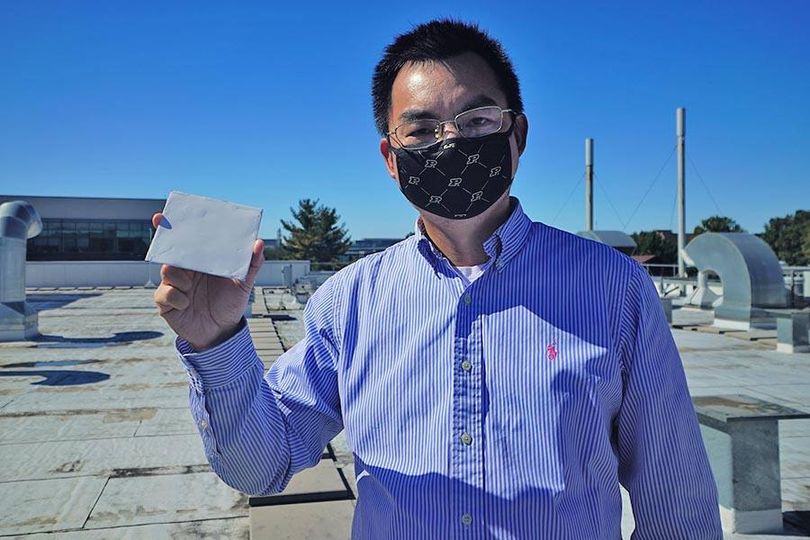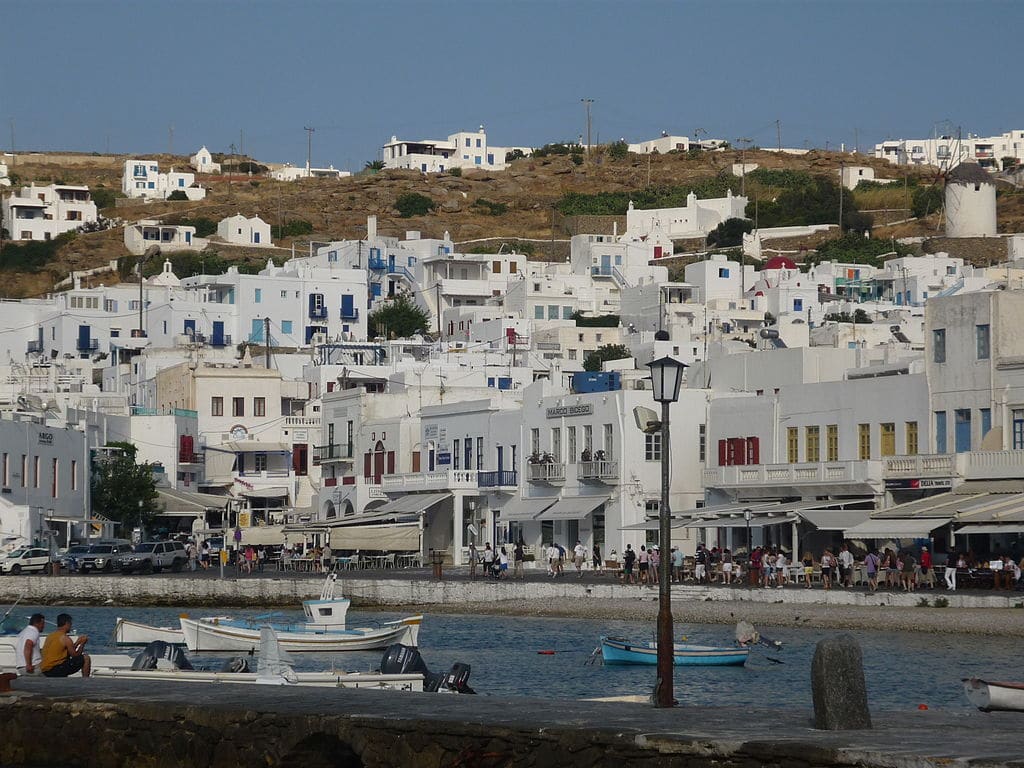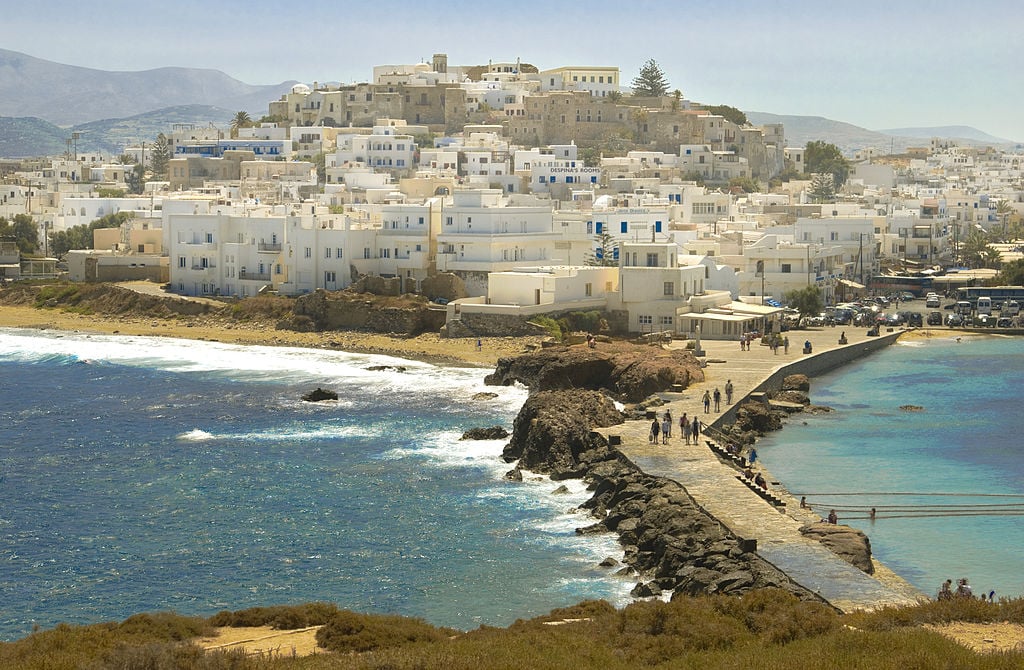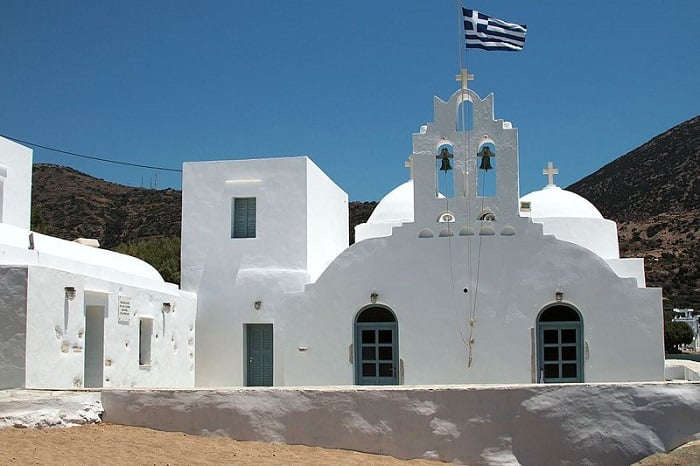
A revolutionary new ultra-white paint, which appears to be just like the brilliant whitewash used on so many buildings on the Cyclades and other Greek islands, could possibly replace air conditioning one day because it reflects so much heat back into space.
Developed recently by researchers of Purdue University, the paint reflects a staggering 98.1 percent of sunlight, a great deal more than the average of 10 to 20 percent of sunlight that most commercial white paints do today.
The new product is so effective that it cools down buildings by up to an incredible 19 degrees Fahrenheit. Xiulin Ruan, a Purdue University professor of mechanical engineering, was a co-author of the scientific article published on the findings.
He and his colleagues believe the paint may help in the fight against global warming and reduce our reliance on air conditioning and even electric-powered air exchangers.

Once applied, the new paint can keep surfaces up to 19 degrees Fahrenheit cooler than their ambient surroundings, according to Purdue. Researchers speculate that the new paint may even be available for purchase in the next year or so.
The scientists responsible for the breakthrough discovery are from Purdue’s mechanical engineering department. They published their groundbreaking findings recently in the journal ACS Applied Materials & Interfaces.

The research study was funded by both the Cooling Technologies Research Center of Purdue and the Air Force Office of Scientific Research (AFOSR).
“Our paint only absorbs 1.9 percent of the sunlight, whereas commercial paint absorbs 10 to 20 percent of sunlight,” explains Ruan.
Contrary to intuition, even white paint absorbs the rays and heat of the sun rather than reflecting most of the heat back into the sky. On sunny days, white paint actually heats up, making it harder to keep interior spaces cooler.
Even the whitest of white paints out there on the commercial market today reflect at most 80 to 90 percent of light, according to Ruan.

The new Purdue paint not only reflects nearly all of the sun’s rays back into space but also sends infrared heat away from the surface of a building This equates to an average cooling power of 113 watts per square meter (10.7 square feet).
When the paint is applied to the roof of a building, the researchers say, this translates into powerful savings.
Cooling effect exceeds that of an air conditioner
On the roof of a 1,000-square-foot home, a cooling power of 10 kilowatts will be generated by the paint, which, Ruan states, is more powerful than most residential central air conditioners.
In broiling Indiana heat, the researchers tested the new paint on a Purdue campus building during midday on sunny days, proving that the paint kept outdoor temps a respectable eight degrees cooler than the ambient temperature at the time.
However, it was at nighttime, when they found the paint led to the surfaces staying 19 degrees cooler than their surroundings, that the revolutionary performance of the paint came to the fore.
“Our paint can lose heat by its own emission—it emits heat to deep space,” Ruan explained to Smithsonian magazine.
“With such little absorption from the sun, our paint loses more heat than it absorbs. This is really exciting for us. Under the sun, it cools below the ambient temperature and that’s hard to achieve,” said Ruan.
Barium sulfate particles are game-changer for ultra white paint
A video produced by the team using an infrared camera exhibits exactly how much the paint cools the surfaces to which it is applied, with the whitest of all white paints represented by a dark purple square in the middle to indicate its cool temperature.
Naturally, commercially-available white paints, even those marketed as heat-rejecting products, are cooler than dark paints, but they are still made with titanium dioxide, which absorbs the ultraviolet rays of the sun, causing any surface they are used on to heat up.
“Commercial white paints are cooler than the other, darker-colored paints, but they are still warmer than the ambient or surrounding temperature,” Ruan notes.
The researchers naturally wanted to try using materials that could reflect, rather than absorb, the brutal UV rays. Testing more than 100 different materials over the past seven years, they finally hit upon barium sulfate after finding that calcium carbonate reflected a surprising 95.5 percent of the sun’s rays.
Incredibly, the barium sulfate was even more effective than the calcium carbonate. Already used in cosmetics as well as photographic papers, the substance is created by reacting
barium hydroxide and other barium sources with sulfuric acid.
Ruan and the other researchers also took two further steps to enhance the paint’s reflective nature, using six times the concentration of barium sulfate particles as most heat-resistant paints on the market. They also used barium particles of different sizes in the mixture.
“We found that if you put different particle sizes in your paint, then each particle size can scatter and reflect different wavelengths and, all together, they reflect the entire spectrum of wavelengths in sunlight,” Ruan says.
The new paint is truly revolutionary – and not just because it would clearly reduce the need for air conditioning.
Paint would lessen heat convection in cities, fossil fuel use
When air conditioners are used, they simply remove the heat and humidity from indoors and transfer it outdoors, increasing the overall heat sink effect of a city or town.
Of course, the use of the paint would also lessen the need for electricity and/or fossil fuels for air conditioning.
The types of electromagnetic waves emitted from the surface of the ultra white paint can pass through the atmosphere and back into deep space, according to the researchers.
“Air conditioners can cool your house, but they move the heat from inside the house to outside—the heat is still in the city, it’s still on the Earth, in our air,” Ruan says.
“So even if you don’t care about the power bills you pay, it’s going to warm up the Earth anyway. Our paint does not use any power but, more importantly, it sends the heat to space. The heat doesn’t stay on the Earth, so that really helps the Earth to cool down and can stop the warming trend,” maintains Ruan.
According to Purdue researchers, the ultra-white paint could reduce air conditioning by up to a staggering 70 percent in desert cities such as Reno, Nevada, and Phoenix, Arizona.
Taking the experiment to an extreme, they extrapolated that should they cover 0.5 to 1 percent of the surface of the earth, including buildings, roads, and unused land, amongst other things, with the ultra-white paint, it would be enough to control global warming.
“It’s a lot of area, but if one day we need to use this approach to help reverse the warming trend, it’s still affordable—the paint is not expensive,” Ruan declares.
Purdue scientists have already applied for a patent on the ultra white paint and are committed to clarifying its durability in residential and commercial use.
Price shouldn’t be a problem, Ruan says, with a gallon costing almost exactly the same as a gallon of ordinary paint right now, approximately $30 to $40 per gallon.
Elizabeth Thompson, vice president of U.S. Green Building Council, is fascinated by the prospects the paint holds for the future.
“When I first heard about it, I was imagining, ‘Wow, this could be utilized in all sorts of different urban conditions in the U.S. and internationally,’” she says.
“Just that potential is so strong and compelling. It’ll be great to see how this evolves and how the researchers are able to develop its applications,” Thompson says hopefully.
The U.S. Green Building Council is the nonprofit group which developed the Leadership in Energy and Environmental Design (LEED) rating system for sustainable buildings. It now offers a “heat island reduction credit” for buildings whose owners are working toward LEED certification levels.
According to Thompson, the new ultra white paint is a game-changer in this field.
Using materials that have an initial solar reflectance of 33 percent at installation or 28 percent over three years is one way owners currently attempt to make buildings more energy-efficient, Thompson says. The Purdue paint’s 98.1 percent solar reflectance rate blows those requirements completely out of the water.
“This is just a whole different ballpark of cooling, which is very exciting,” Thompson declares.
“It’s hopeful,” she says, adding that “This is the kind of thing that we all hope scientists and researchers will help us to discover, opportunities that we didn’t know existed for how to live more sustainably.”
See all the latest news from Greece and the world at Greekreporter.com. Contact our newsroom to report an update or send your story, photos and videos. Follow GR on Google News and subscribe here to our daily email!



